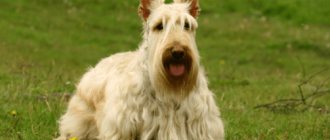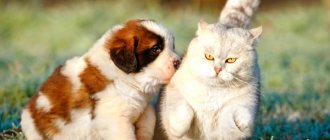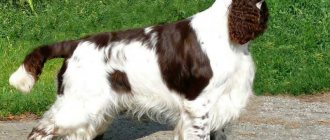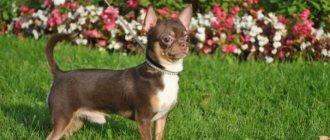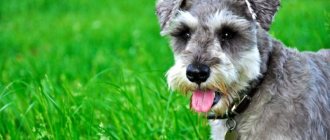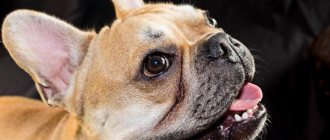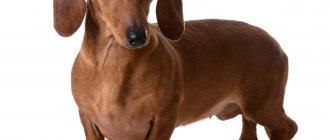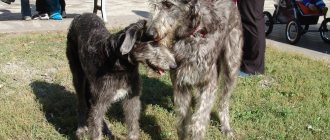Saint Bernard is a good-natured giant, a real nanny for children. It is considered a family dog, but with special training it will become a confident watchman and reliable rescuer.
Every St. Bernard on the street is called Beethoven, like from a movie.
More photos →
| How long do they live? | 8-10 years |
| Weight | not less than 70 kg |
| Height (height at withers): | males 70-90 cm, females 65-80 cm |
| Puppy price | 20-50 thousand rubles depending on pedigree |
Appearance of St. Bernard, breed standard
The Saint Bernard belongs to large breeds, the height at the withers of a male is no less than 70 cm, and that of females is no less than 65 cm. The prototype for the breed was the Tibetan mastiff, the rescuers inherited massiveness: the head is large, the forehead is wide, convex.
FCI-Standard N° 61.
- The muzzle is short, wide, the transition from the forehead to the muzzle is well defined.
- The eyes are medium-sized, slightly sunken, brown.
- The jowls hang down, covering the entire muzzle, the teeth are a full set (42 teeth)
- The ears are drooping, medium in size, and should hang down to the sides of the head.
- The neck is powerful, strong, with a thick collar.
- The chest is wide.
- The paws are widely spaced, the croup is even, rounded, located at the level of the back.
- The tail is carried below the hock joint and the tip is slightly curved upward.
St. Bernard coat and colors
There are two types of coat – longhaired or shorthaired.
Longhair: medium length coat, soft, wavy, with a dense undercoat.
Shorthair: The coat is soft, downy, short, and lies close to the body.
Regardless of coat type, the color can be either white with red markings or red with white markings. Shades of red range from light red to reddish brown.
How to care for a great friend
The impressive dimensions of an adult pet become an obstacle to frequent bathing of the dog, but, according to experienced dog breeders, there is no need to wash the St. Bernard too often. The dog's coat looks well-groomed due to the saturation of natural fatty components that envelop each hair, giving shine to the coat and a well-groomed appearance.
You need to bathe your big friend as he gets dirty or 1-2 times a month, using a special “Yves St. Bernard” shampoo for dogs.
Another huge advantage of the St. Bernard is its virtually tangle-free coat. But you still need to brush your pet 1-2 times a week, this way he will look even more presentable, and he will also get considerable pleasure from the procedure.
During the shedding period (and the dog sheds 1-2 times a year and very heavily), increase the frequency of brushing.
After each meal, wipe your pet's face to remove any remaining food and drool. Before adopting a St. Bernard, consider the profuse salivation characteristic of this breed and ask yourself whether you are ready to keep a dog with this feature.
A mandatory item is caring for your dog’s eyes. Check their condition regularly and wipe the corners with chamomile infusion or weak tea.
In the spring and summer, make sure that the dog does not overheat, keep the St. Bernard in a cool room or outdoors, and change the water throughout the day.
This is a St. Bernard, and this is a Moscow watchdog, don’t get confused!
Both breeds are large, with similar colors, with massive heads, so inexperienced dog lovers often confuse them.
What is the difference between a St. Bernard and a Moscow Watchdog? First of all, the history of the breed, which dates back centuries. The Moscow is much younger - the breed was developed in the 50s of the last century, crossing representatives of the best breeds (St. Bernard also participated).
The breeds also differ in shade: the St. Bernard is white with red, or red with white spots, and the Moscow Watchdog is red and piebald.
The Moscow watchdog retained about 30% of the flexible and kind character of the St. Bernard. Yes, she makes contact, but not with everyone, yes, she is balanced, but also independent, she is self-confident, and does not spend much time thinking about attacking a stranger - she acts with lightning speed and hits on the spot.
The character of St. Bernard and features of socialization
Despite the size of the dog, the four-legged character is soft and good-natured. St. Bernard is a noisy, huge “Porthos in the proud family of Musketeer Great Danes: a big but kind dog.”
Characteristics: strong, calm, balanced, practically non-barking. The Saint Bernard is categorically not suitable for security service, but the appearance of the dog inspires fear. And if the dog starts barking, then it’s worth finding out the reason.
The good-natured nature of the St. Bernard is most noticeable in relationships with children: huge animals are wonderful patient nannies. Despite its size and clumsiness, the St. Bernard is not against active games with children, loves to be in the fresh air, and is not afraid of the cold.
Although pets are human-oriented and friendly, socialization of such a powerful dog is simply necessary. It is important to introduce your puppy to the things that an adult dog will have to deal with on a daily basis: people, dogs and cats. Introduce the dog to the outside world - including public transport. This must be done to prevent a large adult rescuer from running away or harming himself or others out of fear of the unknown.
Surprisingly, St. Bernards, who adore children, do not like small dogs. But if the pet grew up with a small dog, then conflict situations do not arise.
Maintenance and care
It is better to keep a large shaggy dog in an enclosure, in a private house. Saint Bernard easily tolerates cold and is not afraid of frost or snow. But in the summer it will be difficult for such a pet - the dog needs to be provided with shade and constant access to clean drinking water.
You need to comb your dog at least once a week, and every day during the molting period (twice a year). But washing a rescue dog is often not recommended: the St. Bernard’s coat has water-repellent properties, protecting it from snow or rain.
Another peculiarity of the St. Bernard is that the dog often drools - before eating or when it’s hot outside.
Life expectancy is on average 8 years. Susceptible to some diseases:
- Joint dysplasia: elbow and knee. The size of the animal and its weight put a lot of stress on the joints. To avoid the development of the disease, you need to carefully monitor the puppy’s physical activity - do not overload with intense training, do not overfeed.
- An inversion or eversion of the eyelid is a feature of the anatomical structure of the eyes; the St. Bernard seems to be looking from under his brows.
- Epilepsy.
- Cataract.
- Allergic reactions.
Initially, the breed was smaller in size than the modern St. Bernard - it was not susceptible to joint diseases, nor to allergic reactions. NOT conscientious selection, the intervention of fashion in the breed led to an increase in the animal’s body weight and the appearance of frequent allergic dermatitis.
Also prone to gastrointestinal disorders and bloating.
Feeding a St. Bernard puppy
- When purchasing a puppy, you need to ask the breeder what he feeds the babies and this diet must be adhered to at least for the first couple of weeks.
- The frequency of feeding depends on the age of the puppy.
- Up to two months he is fed six times a day (the volume of food is equal to one or two glasses per feeding).
- With age, the single and daily volume of food increases, and the frequency decreases: up to 4 months - 5 times a day, up to 6 - 4 times a day, up to 10 months - 3 times and then twice a day.
Although it is better to feed adult dogs once after an evening walk, especially in the hot season.
What to feed a St. Bernard? Dietary recommendations
The dog's diet should be balanced and varied. If your pet eats commercially prepared food, it is important that the food contains all the necessary vitamins and minerals and is appropriate for the dog’s age. For St. Bernard, food for giant dog breeds is suitable: for puppies, this is fatty food with a minimal fiber content, but with calcium and phosphorus for the formation of bones, it must contain vitamins, microelements for the formation of cartilage tissue, and probiotics.
The choice of feeding type - dry food or natural food - depends on the wishes of the owner, and has both positive and negative sides.
- Dry food. Easy to feed to your dog, convenient to take with you on the road or for training. There is no need to select the composition yourself, observing the dosage. BUT the composition of dry food indicated on the packaging does not guarantee that the granules contain all the names indicated on the label. It is not enough to choose food that is suitable for the dog; it is necessary to give vitamins in courses, especially during the growth period and annually during the molting period, during the bitch’s pregnancy or nursing puppies.
- Natural nutrition. The main difficulty in natural nutrition is the balance of essential substances, vitamins, and microelements that a dog needs. In addition, unlike dry food, natural food needs to be prepared in advance, monitored and varied. But by maintaining a balance of foods, there is no need for additional vitamin supplements. The dog gets used to natural food faster than to dry food; “natural” food causes fewer allergic reactions.
When choosing natural food, you need to remember a few rules:
- Natural food is not food from the table, but separate products for the dog.
- Heat-treated meat does not benefit the predator. The animal’s body is adapted to digest raw meat, obtaining from it the necessary nutrients, protein and vitamins.
- In addition to meat and bones, a predator needs vegetables, fruits, herbs, and berries. Plant foods should make up about 20% of the total diet.
- Under no circumstances should you give your dog boiled bones, sweets (except those specially designed for animals), salty, smoked or fatty foods.
- Periodically introduce fermented milk products into the diet - low-fat cottage cheese, yogurt without fillers and sugar, kefir.
By maintaining a balance in food, the dog will be healthy, and its appearance will please not only the owner.
Natural feeding of St. Bernard
As the dog gets older, the amount of food consumed also increases.
So at 1.5 months they give about 150 grams of meat, and by a year - 600 g. Also, a one-year-old puppy should eat 500 grams of sea fish, 400 grams of cottage cheese, 250 g of porridge, 200 g of vegetables, and up to 500 g of fermented milk products per day.
St. Bernard meat should be raw and cut into pieces. When feeding natural food, it is necessary to add mineral supplements and preparations containing calcium.
A St. Bernard puppy needs growth vitamins - A, E, D for constant calcium support. Therefore, his daily diet should include:
- lactic acid products,
- fresh vegetables,
- cottage cheese,
- boiled eggs,
- sea fish.
An adult St. Bernard can benefit from cartilage and raw bones. It strengthens gums, bones and cleans teeth. Only these should not be the tubular bones of birds. It is better to let puppies chew on tendons.
Saint Bernard nurseries
In Moscow and Moscow region
- Rock crystal gorny-hrustal.jimdo.com +7-915-060-23-14, +7-985-860-40-65, +7-967-180-49-04
- Pearl of Dubna senbernar-chau.narod.ru +7-903-775-25-63
- Curixvan curix.jimdo.com +7-925-830-01-61, +7-925-276-56-32
- Large Paw large-paw.com +7-985-435-07-40
- Datve datve.jimdo.com + 7-926-539-09-39
In St. Petersburg
- Jewel Snow jewelsnow.ru +7-903-093-88-84
In other cities
Nizhny Novgorod
- Royal sen.hotdogs.ru +7-987-551-41-40
Tver region
- Amiras Platinum amirasplatinum.jimdo.com +7-915-741-41-74, +7-980-632-99-21
Tula
- From Angel Grad angelgrad.jimdo.com +7-960-599-50-60, +7-950-911-58-03
Sverdlovsk region
- Gift of the Heart darserdza.jimdo.com +7-950-201-38-27, +7-992-005-86-54
Petrozavodsk
- Alpen Gold alpengold.okis.ru +7-953-526-33-32, +7-911-429-53-02
Novosibirsk
- Owner of the Taiga hozjaintaygi.jimdo.com +7-913-742-33-19, +7-952-917-84-81
Voronezh
- Ursa-ell ursa-ell.ucoz.com +7-906-583-93-50
Origin story
The name "Saint Bernard" comes from the place of origin of the breed - the monastery of St. Bernard in the mountains of Switzerland. Monk Bernard founded a refuge for travelers in the 11th century. The monastery, the trail and the breed of dog are named after the monk (Saint Bernard - St. Bernard). Since the monastery was located high in the mountains, where avalanches and landslides were common, they were used as rescue dogs. The rescue dog's equipment included a barrel of brandy, which was drunk by people under the snow when the dog found and dug them up.
The dog's large size, wide strong paws, thick hair, and thick skin made it a beast of burden - powerful dogs were used to carry loads in the mountains.
There is a legend that St. Bernard Barry saved more than 40 people from the snow during his life. Once he saved a boy whom he carried to the monastery for several kilometers on himself.
The emergence of the heroic breed
Until a monk of one of the monasteries located near the Swiss Alps founded a mountain refuge for travelers on the short but very dangerous mountain road getting to Rome, many of them never reached their final destination, remaining buried under avalanches . No one was looking for them; there was no place to spend the night or wait out the avalanche.
The shelter could only save 3 wanderers who were indoors at the time of the avalanche, and nothing could be done to help those who found themselves in the mountains at the fateful moment. This continued until the 16th century, until huge and strong tailed good-natured creatures appeared in the shelter, who not only sensed the time of an avalanche and warned about it with their behavior, but were also able to find people under the snow rubble and warm them while waiting for rescuers.
Dogs became indispensable helpers in saving people in the mountains, and since they appeared in the shelter founded by the monk Bernard, the breed received the appropriate name.
The Saint Bernard dog is one of the most selfless and heroic breeds, ready to sacrifice itself to save a person. These cute, huge, good-natured dogs cannot imagine their life without serving their master and have proven their loyalty for several centuries.
Photo
A selection of selected photos uploaded using the hashtags #stbernardpuppy, #saintbernardlove, #saintbernard on Instagram.
